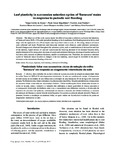Use este identificador para citar ou linkar para este item:
http://www.alice.cnptia.embrapa.br/alice/handle/doc/489075| Título: | Leaf plasticity in successive selection cycles of 'Saracura' maize in response to periodic soil flooding. |
| Autoria: | SOUZA, T. C. de  MAGALHAES, P. C.   PEREIRA, F. J.   CASTRO, E. M. de   SILVA JÚNIOR, J. M. da   PARENTONI, S. N.   |
| Afiliação: | Thiago Corrêa de Souza, UFLA; PAULO CESAR MAGALHAES, CNPMS; Fabrício José Pereira, UFLA; Evaristo Mauro de Castro, UFLA; Jessé Marques da Silva Júnior, UFLA; SIDNEY NETTO PARENTONI, CNPMS. |
| Ano de publicação: | 2010 |
| Referência: | Pesquisa Agropecuária Brasileira, Brasília, v. 45, n. 1, p. 16-24, jan. 2010. |
| Conteúdo: | ABSTRACT: The objective of this work was to assess the effect of successive selection cycles on leaf plasticity of 'Saracura' maize BRS?4154 under periodical flooding in field conditions. Soil flooding started at the six?leaf stage with the application of a 20?cm depth water layer three times a week. At flowering, samples of leaves were collected and fixed. Paradermic and transverse sections were observed under photonic microscope. Several changes were observed throughout the selection cycles, such as modifications in the number and size of the stomata, higher amount of vascular bundles and the resulting decrease of the distance between them, smaller diameter of the metaxylem, decrease of cuticle and epidermis thickness, decrease of number and size of bulliform cells, increase of phloem thickness, smaller sclerenchyma area. Therefore, the successive selection cycles of 'Saracura' maize resulted in changes in the leaf anatomy, which might be favorable to the plant's tolerance to the intermittent flooding of the soil. RESUMO: O objetivo deste trabalho foi avaliar o efeito de sucessivos ciclos de seleção na plasticidade foliar do milho 'Saracura' BRS-4154 sob alagamento intermitente do solo em condições de campo. O alagamento do solo iniciou-se no estádio de seis seis folhas com a aplicação de uma lâmina de 20 cm de água três vezes por semana. No florescimento, foram coletadas e fixadas amostras das folhas. Secções paradérmicas e transversais de amostras foram observadas em microscópio fotônico. Várias modificações foram observadas durante os ciclos de seleção, como o número e o tamanho dos estômatos, a maior quantidade de feixes vasculares e a consequente diminuição da distância entre eles, o metaxilema com diâmetros menores, a diminuição da espessura da cutícula e da epiderme, a diminuição no número e tamanho das células buliformes, o aumento da espessura do floema e a menor área de esclerênquima. Os sucessivos ciclos de seleção do milho 'Saracura', portanto, levaram a mudanças na anatomia foliar, as quais podem ser favoráveis à tolerância da planta ao alagamento intermitente do solo. |
| Thesagro: | Milho Zea mays |
| Palavras-chave: | Anatomia foliar Tolerância ao alagamento |
| Digital Object Identifier: | 10.1590/S0100-204X2010000100003 |
| Tipo do material: | Artigo de periódico |
| Acesso: | openAccess |
| Aparece nas coleções: | Artigo em periódico indexado (CNPMS)  |
Arquivos associados a este item:
| Arquivo | Descrição | Tamanho | Formato | |
|---|---|---|---|---|
| Leafplasticity.pdf | 1,33 MB | Adobe PDF |  Visualizar/Abrir |









